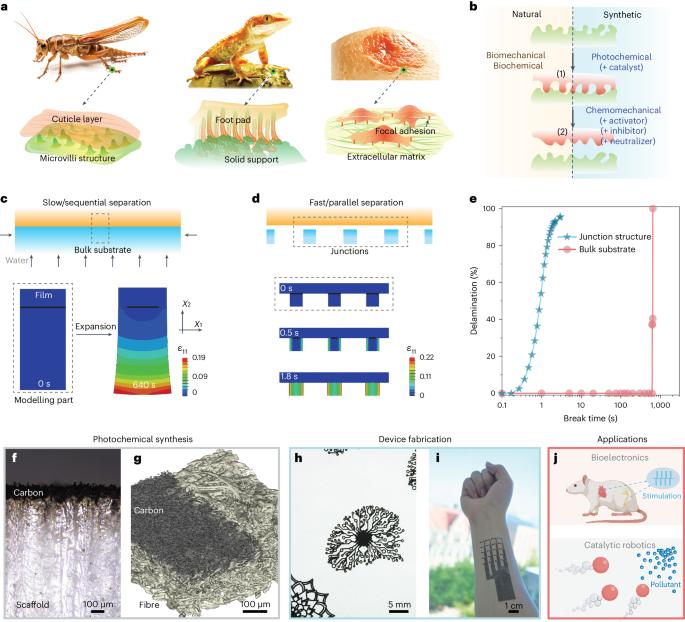可持续设备微细加工的生物启发渗透结方法
IF 25.7
1区 环境科学与生态学
Q1 ENVIRONMENTAL SCIENCES
引用次数: 0
摘要
微加工是制造通常为微米尺度的小型结构的过程,具有广泛的实际应用,但由于在图案化和转移阶段需要消耗大量的化学物质和能源,因此面临着可持续发展的挑战。在此,我们介绍一种生物启发的可渗透结方法,该方法涉及在生物聚合物基质上进行图案化,并使用盐辅助光化学合成,以推进可持续微制造。这种方法利用 "致动器-抑制剂-中和剂 "工艺实现按需粘合和分层。利用水作为绿色致动器,我们的方法实现了图案化器件转移的瞬时分层(1 秒),远远超过了传统技术的功效。这一进步提高了卷到卷的生产速度,并最大限度地减少了能源和有害化学品的消耗。与传统的微加工方法相比,可持续基底和无危害加工的结合大大降低了温室气体排放,减少了器件制造对环境的影响。这种方法广泛适用于从生物电子器件到催化机器人等各种器件制造工艺。总之,这项工作解决了微制造面临的可持续发展挑战,为环保型器件制造铺平了道路。微加工在设备制造中起着至关重要的作用,但同时也会对环境造成不利影响。本研究提出了一种生物启发的可渗透结方法,用于可持续微制造,该方法无需使用有害化学物质,并能最大限度地降低能耗。本文章由计算机程序翻译,如有差异,请以英文原文为准。

A bioinspired permeable junction approach for sustainable device microfabrication
Microfabrication, the process of fabricating small structures usually in micrometre scale, has wide practical applications but confronts sustainability challenges due to the substantial chemical and energy consumption during the patterning and transfer stages. Here we introduce a bioinspired permeable junction approach involving patterning on biopolymer matrices with a salt-assisted photochemical synthesis to advance sustainable microfabrication. This approach leverages an ‘actuator-inhibitor-neutralizer’ process for on-demand adhesion and delamination. Utilizing water as a green actuation agent, our method realizes instantaneous delamination (<1 s) for patterned device transfer, far exceeding the efficacy of traditional technologies. This advancement boosts the roll-to-roll production speed and minimizes the consumption of energy and hazardous chemicals. The combination of sustainable substrates and hazards-free processing substantially lowers greenhouse gas emissions and reduces environmental impacts for device fabrication compared with traditional microfabrication methods. This approach is widely applicable to various device fabrication processes, ranging from bioelectronic devices to catalytic robotics. Overall, this work addresses the sustainability challenges of microfabrication, paving the way to environmentally friendly device fabrication. Microfabrication has an essential role in device fabrication but is accompanied by unfavourable environmental footprint. This study presents a bioinspired permeable junction approach for sustainable microfabrication, which eliminates the use of hazardous chemicals and minimizes energy consumption.
求助全文
通过发布文献求助,成功后即可免费获取论文全文。
去求助
来源期刊

Nature Sustainability
Energy-Renewable Energy, Sustainability and the Environment
CiteScore
41.90
自引率
1.10%
发文量
159
期刊介绍:
Nature Sustainability aims to facilitate cross-disciplinary dialogues and bring together research fields that contribute to understanding how we organize our lives in a finite world and the impacts of our actions.
Nature Sustainability will not only publish fundamental research but also significant investigations into policies and solutions for ensuring human well-being now and in the future.Its ultimate goal is to address the greatest challenges of our time.
 求助内容:
求助内容: 应助结果提醒方式:
应助结果提醒方式:


